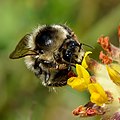| Anthyllis vulneraria | |
|---|---|
 | |
| Scientific classification | |
| Kingdom: | Plantae |
| Clade: | Tracheophytes |
| Clade: | Angiosperms |
| Clade: | Eudicots |
| Clade: | Rosids |
| Order: | Fabales |
| Family: | Fabaceae |
| Subfamily: | Faboideae |
| Genus: | Anthyllis |
| Species: | A. vulneraria |
| Binomial name | |
| Anthyllis vulneraria | |
| Synonyms | |
List
| |
Anthyllis vulneraria, [2] the common kidneyvetch, kidney vetch [3] or woundwort [4] is a medicinal plant [5] native to Europe, northern Africa, and Western Asia. [6] The name vulneraria means "wound healer". [7]



